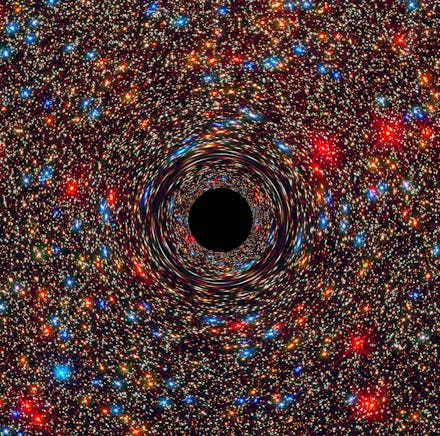Scientists say there could be tens of millions of black holes in our own galaxy

About 26,0000 light-years past Earth, nestled in the center of our Milky Way galaxy, is a strange destination with a strange name: Sagittarius A*. Sagittarius A*, like a hoarder, has gathered about 4 million times as much mass as our sun — but crammed it all into a space smaller than the distance from here to the sun.
Its secret? Incredibly strong gravity — so strong that even individual photons of light can’t slip out of its grasp. Which also, by the way, makes it invisible to our eyes, although specially designed telescopes can spot it. But as wild as that may sound, it’s just a particularly extreme vision of what a team of scientists has now suggested may be happening in as many as 100 million places in the Milky Way alone.
That’s according to a new paper published in Monthly Notices of the Royal Astronomical Society.
The paper was inspired by the findings from a pair of devices known as the Laser Interferometer Gravitational-Wave Observatory. In less than two years, LIGO has eavesdropped three times on the chirp that signals two gigantic black holes merging.
In each case, the black holes involved boasted about 30 suns’ worth of mass. That startled scientists, who had previously believed most black holes would be smaller, more like just one suns’ worth of mass. So they decided to take a step back and look at how black holes are created in the first place.
Most black holes trace their beginnings to the very dramatic ending of a large star (our sun is too small to ever create a black hole). When there’s no more fuel to power the star’s energy production, it throws in the towel and explodes, a process called “going supernova.” The matter that’s left collapses into a super-dense black hole, usually with a few sun’s worth of mass.
But it’s not just size that matters. Stars that contain less metal tend to end up as larger black holes, because they’ve lost less mass as they’ve burned. To get a black hole of about the size of those LIGO has heard combine, you’d need either 90 suns’ worth of highly metallic star or just 33 suns’ worth of metal-poor star.
So the scientists behind the new paper looked at surveys of Milky Way stars and applied what they know about how black holes form to predict the number of black holes, along with their size, that still might be lurking in our stellar neighborhood.
The number they came up with is mind-blowing: There should be millions of black holes with 30 suns’ worth of mass in the Milky Way alone. That makes the collisions LIGO has observed seem less extraordinary — and suggests the detector should catch an even bigger merger of black holes with 50 suns’ worth of mass within the next decade.